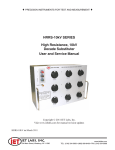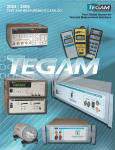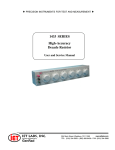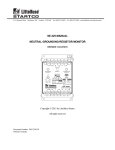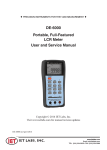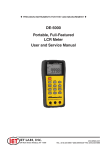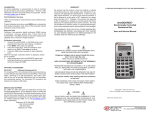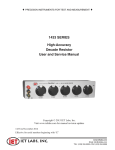Download esi SR1050 Manual
Transcript
♦ PRECISION INSTRUMENTS FOR TEST AND MEASUREMENT ♦ SR-1050 High Accuracy Transfer Standard User and Service Manual Copyright © 2013 IET Labs, Inc. Visit www.ietlabs.com for manual revision updates Effectivity: Serial numbers beginning with E SR-1050 im/May 2013 IET LABS, INC. www.ietlabs.com Email: [email protected] TEL: (516) 334-5959 • FAX: (516) 334-5988 IET LABS, INC. www.ietlabs.com Email: [email protected] TEL: (516) 334-5959 • FAX: (516) 334-5988 SR-1050 Series WARRANTY We warrant that this product is free from defects in material and workmanship and, when properly used, will perform in accordance with applicable IET specifications. If within one year after original shipment, it is found not to meet this standard, it will be repaired or, at the option of IET, replaced at no charge when returned to IET. Changes in this product not approved by IET or application of voltages or currents greater than those allowed by the specifications shall void this warranty. IET shall not be liable for any indirect, special, or consequential damages, even if notice has been given to the possibility of such damages. THIS WARRANTY IS IN LIEU OF ALL OTHER WARRANTIES, EXPRESSED OR IMPLIED, INCLUDING BUT NOT LIMITED TO, ANY IMPLIED WARRANTY OF MERCHANTABILITY OR FITNESS FOR ANY PARTICULAR PURPOSE. i SR-1050 Series WARNING OBSERVE ALL SAFETY RULES WHEN WORKING WITH HIGH VOLTAGES OR LINE VOLTAGES. Dangerous voltages may be present inside this instrument. Do not open the case Refer servicing to qualified personnel HIGH VOLTAGES MAY BE PRESENT AT THE TERMINALS OF THIS INSTRUMENT WHENEVER HAZARDOUS VOLTAGES (> 45 V) ARE USED, TAKE ALL MEASURES TO AVOID ACCIDENTAL CONTACT WITH ANY LIVE COMPONENTS. USE MAXIMUM INSULATION AND MINIMIZE THE USE OF BARE CONDUCTORS WHEN USING THIS INSTRUMENT. Use extreme caution when working with bare conductors or bus bars. WHEN WORKING WITH HIGH VOLTAGES, POST WARNING SIGNS AND KEEP UNREQUIRED PERSONNEL SAFELY AWAY. CAUTION DO NOT APPLY ANY VOLTAGES OR CURRENTS TO THE TERMINALS OF THIS INSTRUMENT IN EXCESS OF THE MAXIMUM LIMITS INDICATED ON THE FRONT PANEL OR THE OPERATING GUIDE LABEL. ii SR-1050 Series Table of Contents Chapter 1 Introduction 1.1 Overview................................................................................................................ 1 1.2 Improvements made by IET................................................................................... 2 Chapter 2 Specifications 2.1 Specifications......................................................................................................... 3 Chapter 3 Installation 3.1 Initial Inspection.................................................................................................... 5 3.2 Installation.............................................................................................................. 5 3.3 Repackaging for Shipment..................................................................................... 5 3.4 Storage................................................................................................................... 5 Chapter 4 Operation 4.1 Inspection and operation........................................................................................ 6 4.2 Setting for Various Resistance Combinations........................................................ 6 4.2.1 Output terminals.......................................................................................... 6 4.2.2 Controls........................................................................................................ 6 4.2.3 Setting resistance......................................................................................... 6 4.2.4 Transfer accuracy........................................................................................ 10 4.2.5 High Accuracy Calibration Transfer............................................................ 10 4.2.6 Basic Transfer Accuracy.............................................................................. 11 4.2.7 Example transfer.......................................................................................... 12 4.3 Use as a Stand-Alone Standard.............................................................................. 12 4.4 Use as a Precision Voltage Divider........................................................................ 12 4.5 General Considerations for best performance........................................................ 12 Chapter 5 Calibration 5.1 Verification of Performance................................................................................... 13 5.1.1 Calibration interval...................................................................................... 13 5.1.2 General considerations................................................................................. 13 5.1.3 Calibration procedure.................................................................................. 13 5.2 Making adjustments............................................................................................... 14 iii SR-1050 Series Figures and Tables Figure 1-1: SR-1050 Transfer Standard................................................................... 1 Figure 2-1: Sample calibration chart........................................................................ 3 Figure 2-2: Typical operating guide.......................................................................... 4 Figure 4-1: A and B binding post terminals.............................................................. 6 Figure 4-2: Switch positions..................................................................................... 6 Figure 4-3: Resistance = 1R: single resistor............................................................ 7 Figure 4-4: Resistance = 2R: two resistors in series................................................ 7 Figure 4-5: Resistance = 1R: three groups of three, series-parallel......................... 8 Figure 4-6: Resistance = 10R: ten resistors in series.............................................. 8 Figure 4-7: Resistance = R/10: ten resistors in parallel........................................... 9 Figure 4-8: Resistance = 0.4R: 5 groups of 2, in series-parallel.............................. 9 Figure 4-9: Unit configured as a precision voltage divider with 50% ratio................ 9 Figure 4-10: Sample calibration chart...................................................................... 10 iv SR-1050 Series Chapter 1 INTRODUCTION 1.1 Overview The SR-1050 Series (Figure 1-1) is a family of transfer standards suitable for making resistance calibration transfer measurements from 100 kΩ to 100 MΩ, with step sizes of either 1 MΩ or 10 MΩ In order to perform calibrations with a high degree of accuracy, reference standards must normally be employed at every range or decade of the measuring or calibration instrumentation. Clearly this can be difficult and costly, since these standards must be highly stable and their values must be known with a high degree of certainty and with a sufficient resolution. To minimize the cost and difficulty, a more practical means of performing such calibrations is to use transfer standards. The SR-1050 Series of transfer standard consists of 11 matched equal value resistors, R, which may be connected in series or parallel combinations to produce a number of values such as R/10, 1R, and 10R, thereby allowing progressive transfers to higher or lower decades. For lower resistance values (below 100 kΩ), the SR-1010 Series of transfer standards may by used. Figure 1-1: SR-1050 Transfer Standard Introduction 1 SR-1050 Series The transfer standard may be calibrated using a single primary standard. This transfer standard may then be used at R/10, 1R, and at 10R, where R is the step size. It may be used at these three decades with an uncertainty that is equal to the initial calibration uncertainty of the steps plus the transfer uncertainty. For example, if a 1 MΩ step SR-1050 unit has a nominal uncertainty of 10 ppm and a transfer accuracy of 2 ppm, then it may be used at 100 kΩ and 10 MΩ with an uncertainty of 12 ppm (10 ppm + 2 ppm). The nominal adjustment error (the difference between actual value and nominal) for all three decades is essentially the same, e.g. if the adjustment error at 1 MΩ is 10 ppm, then it is also 10 ppm at 100 kΩ and 10 MΩ, remembering that the transfer accuracy error has to be added at these additional decade settings. The SR-1050 standards are constructed using matched low temperature coefficient, hermetically sealed resistors for high stability and imperviousness to moisture. Each resistance step is composed of multiple individual resistors for better power handling, heat distribution, and higher voltage capability. In addition, there is a trimming network that allows precise setting of the resistance step values, and greatly simplifies subsequent calibrations. The switches are of special low-leakage construction. Switches are placed at every junction and at the two ends of the series string to connect that junction to either of the two binding posts; a center-off setting provides for no connection to that junction. By means of these switches, the resistances may be connected in various series-parallel combinations. Low-thermal-emf, five-way binding posts are used for connections to the two buses, and a shielded bnc connector provides for connection to one end of the resistor string. A third binding post provides a connection to the metal case; this may be used as a guard. The unit is housed in a contamination-and-moistureresistant case The insulation materials in the instrument are Kel-F plastic and teflon, for the highest possible resistance and low moisture absorption. 1.2 Improvements made by IET IET Labs updated and improved model SR-1050 from its esi/Tegam version. The model now exhibits better performance in almost all specifications including: • • • • 2 Improved calibration accuracy Improved adjustment accuracy Improved long-term stability (30 ppm compared to 50 ppm) Internal calibration adjustment capability (not possible previously) Introduction SR-1050 Series Chapter 2 SPECIFICATIONS For convenience, a calibration chart, shown in Figure 2-1, is affixed to the side of the unit. This gives the individual and progressive cumulative deviations from nominal. These are deviations which may be used for transfers. For additional convenience to the user, the pertinent specifications are given in an OPERATING GUIDE also affixed to the case of the instrument. Figure 2-22 shows a typical example. 2.1 Specifications Step Size Stability Temperature Adjustment Transfer Stability accuracy accuracy ppm/year long term coefficient Matching Adj. Acc. TC 1 MΩ ±20 ppm ±2 ppm ±15 ppm ±30 ppm ±3 ppm/°C ±10 ppm ±3 ppm 10 MΩ ±20 ppm ±2 ppm ±15 ppm ±30 ppm ±5 ppm/°C ±10 ppm ±3 ppm Calibration conditions: 23°C, low-power, with meter guard applied to COMMON and ground applied to GND, traceable to SI Initial calibration data for each resistor is supplied with the instrument. Leakage resistance: >10 TΩ from terminal to case Environmental conditions: Operating: 10°C to 40°C; <50% RH Storage: -40°C to 70°C Dimensions: 35.6 cm W x 16.5 cm H x 10.2 cm D (14” x 6.5” x 4”) Weight: 5 kg (11 lbs) Power coefficient: <±0.05 ppm/mW per resistor SR1050-10M Maximum applied input: 2500 V, or 1 W per resistor, or 10 W for entire unit (whichever applies first) Breakdown voltage: 3,500 peak between any terminal and case Connection terminals: Three gold-plated, 5-way, tellurium-copper binding posts with low thermal emf and low resistance. One shielded bnc terminal labeled COMMON, used when the unit is employed as a precision voltage divider. Deviation from Nominal R1 R2 R3 R4 R5 R6 R7 R8 R9 R10 R11 Individual Cumulative (ppm) (ppm) -3.7 -3.7 -6.2 -5.0 -0.9 -3.6 -18.4 -7.3 -9.3 -7.7 0.4 -6.3 -15.7 -7.7 -16.1 -8.7 -5.8 -8.4 -3.2 -7.9 -1.1 -7.3 www.ietlabs.com Temperature: 23.5°C Date: 15-Feb-2013 Date Due: Model: SR1050-10M Serial Number: 20309831050A BY: CN Traceable to SI Long Island, NY Email: [email protected] Phone No: 516-334-5963 Figure 2-1: Sample calibration chart Specifications 3 SR-1050 Series SR-1050 HIGH ACCURACY TRANSFER STANDARD CONSULT INSTRUCTION MANUAL FOR PROPER INSTRUMENT OPERATION ±10 ppm Adj. Acc. ±3 ppm TC Matching ±3 ppm/°C Stability Temperature Adjustment Transfer Stability accuracy accuracy ppm/year long term coefficient ±30 ppm Step Size ±15 ppm R10 R11 ±2 ppm R9 ↓ ↑ Off ±20 ppm R8 ↓ Off ↑ 1 MΩ R7 ↓ Off Off ±3 ppm R6 ↓ Off Off ±10 ppm R5 ↓ Off ↓ ±5 ppm/°C R4 ↓ Off Off ±30 ppm R3 ↓ Off Off ±15 ppm R2 ↓ Off ↑ ±2 ppm R1 ↓ Off Off ±20 ppm R0 ↑ Off Off SN: E1-1306210 Calibration conditions: 23°C, low-power, with meter guard applied to COMMON and ground applied to GND, traceable to SI Initial calibration data for each resistor is supplied with the instrument. Leakage resistance: >10 TΩ from terminal to case Power coefficient: <±0.05 ppm/mW per resistor Maximum applied input: 2500 V, or 1 W per resistor, or 10 W for entire unit (whichever applies first) Breakdown voltage: 3,500 peak between any terminal and case SR-1050-10M Off Off Off ↓ ↓ ↓ 10 MΩ To set standard to R/10 To set standard to 10R To set standard to 1R Note: R0 is the left most switch Connection terminals: Environmental conditions: Three gold-plated, 5-way, tellurium-copper binding Operating: 10°C to 40°C; <50% RH posts with low thermal emf and low resistance. Storage: -40°C to 70°C One shielded bnc terminal labeled COMMON, used MODEL: when the unit is employed as a precision voltage divider. WARNING • Long Island, NY • Email: [email protected] • Tel: (516) 334-5959 • www.ietlabs.com SR-1050 bottom label/04-02-2013 Observe all safety rules when working with high voltages or line voltages. Connect the (G) terminal to earth ground in order to maintain the case at a safe voltage. Whenever hazardous voltages (>45 V) are used, take all measures to avoid accidental contact with any live components: a) Use maximum insulation and minimize the use of bare conductors. b) Remove power when adjusting switches. c) Post warning signs and keep personnel safely away. IET LABS, INC. CAGE CODE: 62015 Figure 2-2: Typical operating guide Specifications 4 SR-1050 Series Chapter 3 INSTALLATION 3.1 Initial Inspection 3.3 Repackaging for Shipment IET instruments receive a careful mechanical and electrical inspection before shipment. Upon receipt, verify that the contents are intact and as ordered. The instrument should then be given a visual and operational inspection. If the instrument is to be returned to IET Labs, contact the Service Department at the number or address, shown on the front cover of this manual, to obtain a “Returned Material Authorization” (RMA) number and any special shipping instructions or assistance. Proceed as follows: If any shipping damage is found, contact the carrier and IET Labs. If any operational problems are encountered, contact IET Labs and refer to the warranty at the beginning of this manual. Save all original packing material for convenience in case shipping of the instrument should become necessary. 3.2 Installation For a rack mounted model, installation on a 19 inch rack may be made using the slots in the rack mounting ears. A mounting location that does not expose the unit to excessive heat is recommended. For bench models, no installation as such is required, because this instrument series is not powered. Since it is a high-accuracy instrument, it is recommended that a bench space be provided that would not expose it to abuse and keep it protected from temperature extremes and contaminants. Installation 1. Attach a tag to the instrument identifying the owner and indicate the service or repair to be accomplished. Include the model number, the full serial number of the instrument, the RMA number, and shipping address. 2. Wrap the instrument in heavy paper or plastic. 3. Protect the front panel and any other protrusions with cardboard or foam padding. 4. Place instrument in original container or equally substantial heavy carton. 5. Use packing material around all sides of instrument. 6. Seal with strong tape or strapping. 7. Mark shipping container “DELICATE INSTRUMENT,” “FRAGILE,” etc. 3.4 Storage If this instrument is to be stored for any extended period of time, it should be sealed in plastic and stored in a dry location. It should not be exposed to temperatures below -10°C or above +50°C. Extended exposure to temperature extremes can result in an irreversible change in resistance and would require recalibration. 5 SR-1050 Series Chapter 4 OPERATION 4.1 Inspection and operation This instrument was carefully inspected before shipment. It should be in proper electrical and mechanical operating order upon receipt. An OPERATING GUIDE and a CALIBRATION CHART are attached to the case of the instrument to provide ready reference to specifications. 4.2 Setting for Various Resistance Combinations 4.2.1 Output terminals The SR-1050 Series Transfer Standard, may be set into any number of parallel and/or series combinations to produce different resulting net resistances. These combinations are produced at binding post terminals labeled A and B. See Figure 4-1 below. A B Figure 4-1: A and B binding post terminals For resistance applications, connect to the A and B binding posts. A guard shield may be connected to the GND binding post. 6 4.2.2 Controls Selection of desired resistance is controlled by 12 switches located on the front panel. These switches redirect the electric circuit either through or around internal resistors, and enabling the user to select series and parallel resistance as required. Each switch has three possible positions: OFF (no connection), A (connection to the A terminal), and B (connection to the B terminal). See Figure 4-2 below. Switch in OFF position Switch in A position Switch in B position Figure 4-2: Switch positions 4.2.3 Setting resistance Set the switches as desired to obtain the desired resistance between the A and B binding posts. For example, for the easiest way to get a value of 1R where R is the step size: 1. Set the first switch to B. This connects the lower end of R1 to the B binding post. 2. Set the next switch to A. This connects the upper end of R1 to the B binding post. Thus, we now have R1 connected between the A and B binding posts for an effective value of 1R. See Figure 4-3. Note: Although this is the easiest way to get 1R, the best method is depicted in Figure 4-5. The advantage of the configuration shown in that figure is that it uses the combined value of nine resistors, and allows the use of the same adjustment error. Operation SR-1050 Series A A COMMON R1 R3 R5 R7 R9 R11 GND R2 R4 R8 R6 R10 B B Figure 4-3: Resistance = 1R: single resistor Using the above method to get the value of 2R: 1. Set the first switch to B. This connects the lower end of R1 to the B binding post. 2. Set the third switch to A. This connects two resistors in series between A and B for an effective resistance of 2R. See Figure 4-4. A A COMMON R1 R3 R5 R7 R9 R11 GND R2 R4 R6 R8 R10 B B Figure 4-4: Resistance = 2R: two resistors in series The same method may be applied from 1R to 11R. Operation 7 SR-1050 Series More complex resistance settings may be achieved. Below are just some of the examples. Figure • For a composite value of 1R spread over 9 resistors (which allows the use of the same adjustment error), see Figure 4-5. • For a composite value of 10R, see Figure 4-6. • For a composite value of R/10, see Figure 4-7. • For a composite value of 0.4R, see Figure 4-8. • For a precision voltage divider with 50% ration, see Figure 4-9. A A COMMON R1 R3 R5 R7 R9 R11 GND R2 R4 R8 R6 R10 B B Figure 4-5: Resistance = 1R: three groups of three, series-parallel A A COMMON R1 R3 R5 R7 R9 R11 GND R2 R4 R6 R8 R10 B B Figure 4-6: Resistance = 10R: ten resistors in series 8 Operation SR-1050 Series A A COMMON R1 R3 R5 R7 R9 R11 GND R2 R4 R8 R6 R10 B B Figure 4-7: Resistance = R/10: ten resistors in parallel A A COMMON R1 R3 R5 R7 R9 R11 GND R2 R4 R8 R6 R10 B B Figure 4-8: Resistance = 0.4R: 5 groups of 2, in series-parallel A A COMMON DVM R1 R3 R5 R7 R9 R11 GND R2 R4 R6 R8 R10 V Source B B Figure 4-9: Unit configured as a precision voltage divider with 50% ratio (in this example) Operation 9 SR-1050 Series 4.2.4 Transfer accuracy The deviations of each individual resistor from its nominal value, as well as the cumulative average deviation of the resistance string is given in a CALIBRATION CHART attached to the unit. Figure 4-10 shows a typical chart. SR1050-10M Deviation from Nominal R1 R2 R3 R4 R5 R6 R7 R8 R9 R10 R11 Individual Cumulative (ppm) (ppm) -3.7 -3.7 -6.2 -5.0 -0.9 -3.6 -18.4 -7.3 -9.3 -7.7 0.4 -6.3 -15.7 -7.7 -16.1 -8.7 -5.8 -8.4 -3.2 -7.9 -1.1 -7.3 www.ietlabs.com Temperature: 23.5°C Date: 15-Feb-2013 Date Due: Model: SR1050-10M Serial Number: 20309831050A BY: CN Traceable to SI It is desirable to have as few standards that must be calibrated by national laboratories as possible. The best plan in the case of resistance is to have 1 Ω or 10 kΩ standard resistors for reference standards. One can then compare by ratio techniques the transfer standards to the reference standards. The technique for transferring is based on the fact that ten nominally equal resistors in series have ten times the resistances as one; ten resistors in parallel have one-tenth the resistance of one. The resistance deviation of either the series or parallel case is the same as the average deviation of the ten resistors. The resistance from 1 Ω to higher levels (such as 10 kΩ) is described in the Instruction Manual for IET Model SR-1010 Resistance Transfer Standard. Long Island, NY Email: [email protected] Phone No: 516-334-5963 Figure 4-10: Sample calibration chart What is important to note is that any series, parallel, or series-parallel configuration results in the net deviation being essentially equal to the average deviation for that group of resistors regardless of how they are connected, as long as the power applied is divided equally, (or almost equally) among the resistors. This is clearly the case with the R/10 and the 10R configurations, i.e. that they have they have the same deviations. It is also true with the 9-resistor series-parallel configuration, since the effect of the deviation of the single missing resistor may be safely neglected. This property is very useful since it permits making accurate transfers across three decades with one single unit. A single high accuracy, high stability standard whose value is traceable to SI may thus be transferred to other values using the SR-1050 Series in various combinations. 10 4.2.5 High Accuracy Calibration Transfer The technique is based on the fact that ten nominally equal resistors in series have ten times the resistances as one; ten resistors in parallel have one-tenth the resistance of one. The resistance deviation of either the series or parallel case is the same as the average deviation of the ten resistors. This is discussed in detail in Section 4.2.6. The Model SR-1050 Transfer Standards can be used to transfer resistance from 10 kΩ to 100 MΩ using only 1 to 1 comparisons as on a comparison bridge or other ratio technique. The procedure is to set a 100 kΩ per-step transfer standard for one-tenth the step resistance (10 kΩ) and compare it to the standard resistor. This gives the average deviation of the ten 100 kΩ resistors. The next step is to set the 100 kΩ per-step transfer standard for ten times the step resistance (1 MΩ) and compare it to a 10 MΩ per-step transfer standard that is set to one-tenth the step resistance (also 1 MΩ). This gives the average deviation of the ten 1 MΩ resistors which can be set in series to be 100 MΩ with the same deviation. Figures 4-6 and 4-7 illustrate switch positions for ten times and one-tenth times the nominal value of the transfer standard, in each case using the same ten Operation SR-1050 Series resistors. Figure 4-5 illustrates a method of switching to connect the nine resistors in series and parallel to equal the nominal resistance value of one step. The resistance of the same ten resistors in parallel will be: 4.2.6 Basic Transfer Accuracy To make transfer measurements which do not depend on the absolute accuracy of the transfer standard but only on it’s short term stability, it is necessary to assume that ten resistors in parallel are exactly equal to one one-hundredth of the same ten resistors in series. To see how valid this assumption is let R be the nominal value of the individual resistors and dn the deviation from nominal of this nth resistor. The value of the nth resistor will then be Rn = R(1+dn). The value of the ten resistor in series will be: where The assumption being that is negligible. Since dn maximum for the SR-1050 is less than 100 ppm d2n will be less than 0.01 ppm, which can be neglected. Thus the original assumption is quite valid. A similar analysis can be made for the series-parallel connection or any other configuration in which the power divides equally among the resistors. Operation 11 SR-1050 Series 4.2.7 Example transfer 4.4 Use as a Precision Voltage Divider For example, a 100 kΩ standard may be compared with a SR-1050 unit with 1 MΩ steps connected in parallel as shown in Figure 4-7 above, to provide a 100 kΩ resistance. Once a comparison is made, a net deviation of the parallel R/10 combination is obtained. This average or net deviation remains constant for all combinations. Thereby, the standard is effectively “transferred” with the same deviation plus the transfer accuracy of the unit to another decade, 10R or 10 MΩ in this example. It may also be transferred to the single step R value with the series parallel combination. See Figure 4-5. This process may be continued with another transfer standard, 10 MΩ steps in this example, which would first be configured in the R/10 mode to produce 1 MΩ to start, and then 10 MΩ and 100 MΩ with the same deviation. The transfer uncertainty should still be added at each transfer. The SR-1050 unit may be used as a precision voltage divider. See Figure 4-9, reproduced below. For this application: 1. Connect the input voltage low to COMMON bnc connector and the high to the B binding post. 2. Obtain the “tap,” or ratio voltage from the A binding post to COMMON. 4.5 General Considerations for best performance Since the SR-1050 is a precision high resistance unit, any electrical leakage across the terminals will affect performance. To keep the leakage low, keep the unit clean. This is particularly important for the binding post area, including the white insulating washers underneath. Follow the guidelines below to ensure cleanliness and low leakage: • 4.3 Use as a Stand-Alone Standard Whenever an application requires a resistance standard that has an accuracy that is met by the initial or long term accuracies of the SR-1050 Series, as specified, the SR-1050 unit may be used as a calibration source at any value desired. For example, the SR-1050-1MΩ step unit may be used as a calibration source with an adjustment accuracy of 20 ppm and a stability of 15 ppm/year. • • Keep the unit sealed and in a dry laboratory environment when not in use. Do not handle the white insulators under the binding posts with bare hands. If necessary, clean the binding post area with rubbing alcohol and a lint-free cloth. For 10 MΩ step units, allow the measurement to stabilize for as long as one or two minutes to settle to within specifications. This is needed because of the different effects of meter and bridge test currents on the very long resistance wire making up each resistor. A A COMMON DVM R1 R3 R5 R7 R9 R11 GND R2 R4 R6 R8 R10 V Source B B 12 Figure 4-9: Unit configured as a precision voltage divider with 50% ratio (in this example). Operation SR-1050 Series Chapter 5 CALIBRATION 5.1 Verification of Performance 5.1.1 Calibration interval It is recommended that the SR-1050 Series instruments should be verified for performance at a calibration interval of twelve (12) months. This procedure may be carried out by the user (if a calibration capability is available), by IET Labs, or by a certified calibration laboratory. If the user should choose to perform this procedure, then the considerations below should be observed. Note: For SR-1050 series to be used as transfer standards only, recalibration is not strictly required assuming that there has been no drastic change in the deviations of any individual resistors. 5.1.3 Calibration procedure 1. Determine the allowable upper and lower limits for each resistance step. These are the specified long term accuracy limits. 2. Perform measurements under stabilized temperatures and with the SR-1050 instrument case connected to the appropriate measuring instrument guard point. 3. Confirm that the resistances fall within these limits. If any resistances fall outside these limits, they may be calibrated as described in section 5.2 below. 4. If desired, the new verified values may be entered on a facsimile of the calibration chart in Figure 4-10 and affixed in place of or on top of the existing calibration chart. 5.1.2 General considerations It is important, whenever calibrating or certifying the SR-1050 Series Transfer Standards, to be very aware of the capabilities and limitations of the test instruments used. A resistance standard and a DMM with sufficient capability is recommended. It is important to allow both the testing instrument and the SR-1050 standard to stabilize for a number of hours at laboratory conditions of temperature and humidity. There should be no temperature gradients across the unit under test. Proper metrology practices should be followed in performing this verification or calibration. Special care should be exercised for the high resistance values Calibration 13 SR-1050 Series 5.2 Making adjustments If any individual resistors requires adjustments, the associated resistor network may be trimmed by adjusting the potentiometer for that resistance. CAUTION Don’t touch anything inside the unit with bare hands. If it should become necessary to handle any internal component, gloves should be worn. This procedure should be performed in an environment as free as possible from electrical noise due to the high impedance of these instruments. If this is not possible, or for best results, the effects of such noise may be minimized by the use of a Faraday cage and/or a ground plane. 1. Loosen the four captive screws at the corners of the SR-1050 unit and carefully lift the unit out of the enclosure. 2. Set it on a teflon or styrofoam insulating pad. 3. Connect the DMM across the A and B binding posts with any guard shield connected to the center metal binding post. 4. Set the switches as needed to access each resistor. 5. Locate the trimming potentiometer for each resistor; unlock the potentiometer and adjust to trim the step under test. 6. After making the adjustment, move away from the unit and allow the measurement to settle to its final reading. This procedure can be time-consuming, requiring several minutes for each step. 7. After Adjustment of all required resistances in the unit, return it to its enclosure and fasten with the four retaining screws. 8. Recheck all 11 values, and repeat the adjustment procedure if necessary 14 Calibration





















